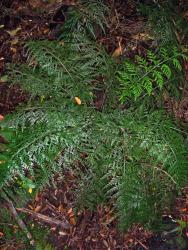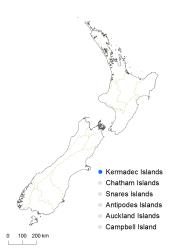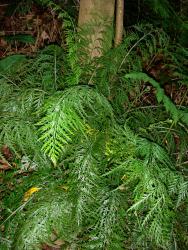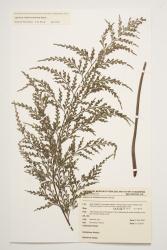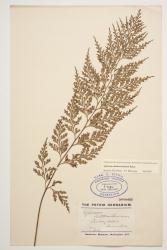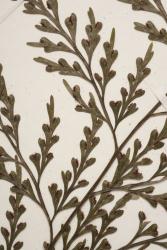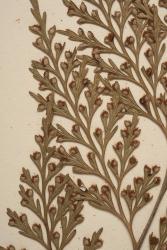- ≡ Asplenium flaccidum var. shuttleworthianum (Kunze) Hook.f., Handb. New Zealand Fl. 374 (1864)
- ≡ Asplenium bulbiferum var. shuttleworthianum (Kunze) G.M.Thomson, Ferns New Zealand 76 (1882)
Terrestrial or rupestral ferns. Rhizomes short, erect or short-creeping, bearing scales. Rhizome scales subulate with long filiform apices, 12–20 mm long, 1–2 mm wide, red-brown, clathrate. Fronds 100–860 mm long. Stipes 30–500 mm long, brown proximally and abaxially, green distally and adaxially, bearing very scattered acicular scales with long filiform apices. Rachises green, almost glabrous or with a few scales. Laminae 2-pinnate-pinnatifid to 4-pinnate, ovate or elliptic, narrowed to a pinnatifid apex, usually overlapping, 70–580 mm long, 35–350 mm wide, yellow-green on both surfaces, coriaceous, almost glabrous or bearing a few scattered scales. Primary pinnae in 7–17 pairs below pinnatifid apex; proximal pinnae ovate or broadly ovate, those at mid-lamina ovate or narrowly ovate; the longest at or below the middle, 25–200 mm long, 10–110 mm wide, apices acute to acuminate, bases long-stalked; costae of primary pinnae not winged or narrowly winged only at distal end. Secondary pinnae gradually decreasing in length along each primary pinna to the distal end; the longest proximal secondary pinnae ovate, 8–96 mm long, 3–24 mm wide, apices acute, bases stalked or sessile; the distal ones narrowly oblong or narrowly obovate, apices acute or obtuse, bases adnate. Tertiary pinnae linear or narrowly elliptic or elliptic, 6–18 mm long, 1–6 mm wide, themselves divided into linear segments on the largest fronds, bases stalked or adnate; ultimate segments up to 6 mm long, 1–1.5 mm wide, apices acute or obtuse, bases adnate. Sori submarginal near tips of sometimes slightly expanded ultimate segments; indusia 1–5 mm long, straight; free margins of indusia entire. Mean spore size 51–63 μm long, 34–44 μm wide; perispores prominently winged and granular, but not conspicuously ridged.
Asplenium shuttleworthianum is recognised by its 2–4-pinnate fronds, with rather short sori confined to the often slightly expanded tips of the ultimate segments. In the New Zealand region the species is known only from the Kermadec Islands.
Kermadec Islands
Altitudinal range: 40–200 m.
Asplenium shuttleworthianum occurs on Raoul, North Meyer, South Meyer and Napier Islands in the northern Kermadec Islands (Sykes 1977), and on Macauley and Cheeseman Islands in the southern Kermadec Islands (de Lange 2015a, 2015b). It usually grows at low altitudes on all the islands, reaching 200 m on Macauley Island.
Also Pitcairn Island and possibly elsewhere in the Pacific.
On Raoul Island, Asplenium shuttleworthianum grows in fissures and crevices on coastal cliffs and rocks, or under coastal forest on andesite, scoria, or pumiceous ground. On North and South Meyer Islands it grows on tuff slopes in ground burrowed by petrels (Sykes 1977). It varies considerably in size from small, stunted plants in exposed sites to large plants in shaded forest.
Asplenium shuttleworthianum was given a conservation status of Naturally Uncommon by de Lange et al. (2013).
There is evidence that A. shuttleworthianum hybridises with A. decurrens (as A. obtusatum subsp. northlandicum) (Brownsey 1977a) and A. flaccidum sensu lato (newly recorded here). The combination A. oblongifolium × shuttleworthianum was recorded from Macauley Island in the southern Kermadec Islands by de Lange (2015a), but the specimen (AK 325824) is morphologically much closer to specimens of A. flaccidum × shuttleworthianum. However, A. flaccidum has not yet been recorded from the southern Kermadecs, and the identity of the hybrid remains in doubt.
n = c.144 (Brownsey 1977b).
The relationship between Asplenium shuttleworthianum and A. gibberosum and similar forms in the Pacific requires further investigation. Trichomanes gibberosum was described by Forster (1786) from an unknown locality in the Pacific and then treated in Davallia (Swartz 1801) and Loxoscaphe (Moore 1853) before being accepted in Asplenium (Mettenius 1870). It is known from Vanuatu, Fiji, Tonga, Rarotonga, Tahiti, and Pitcairn Island, and possibly Samoa, where it is known as A. multifidum, a species originally described from Tahiti (Brackenridge 1854). A more finely divided and proliferous species from Fiji was described as Davallia foeniculacea by Hooker (1861), before being transferred to Loxoscaphe (Moore 1857–1862) and then treated in Asplenium as A. stenolobum (Christensen 1905–1906). A similar-looking plant was described from Samoa as A. powellii by Baker (in Hooker & Baker 1867). Meanwhiile A. shuttleworthianum was described as a distinct species from Pitcairn Island by Kunze (1840–1851), but never critically compared with material elsewhere in the Pacific, possibly because at that time it was treated in Davallia, or later as Loxoscaphe. Indeed, it was not mentioned in early accounts of the plants of Pitcairn Island (Brown & Brown 1931; Copeland 1938; Brownlie 1961), which all referred only to the presence of Loxoscaphe gibberosum. Göthesson (1997) listed the species on Pitcairn as Asplenium gibberosum and noted only that some uncertainty seemed to exist as to whether the species should be known as A. gibberosum or A. shuttleworthianum. However, he did not include the latter name in the synonymy.
The name A. shuttleworthianum was first used in a New Zealand context by Hooker (1864), who treated it as one of six varieties of A. flaccidum, but one confined to the Kermadec Islands. It was later raised to species rank by Cheeseman (1925), who noted that "it was discovered on Pitcairn Island by Mr Cuming, but has since been found in the Samoan Group and elsewhere in Polynesia". Sykes (1977) also claimed that "A. shuttleworthianum is recorded from parts of tropical Polynesia as far east as Pitcairn". However, identified collections of A. shuttleworthianum have only been collected from Pitcairn Island (Kunze 1840–1851) and the Kermadec Islands (Cheeseman 1925; Allan 1961; Sykes 1977). Such a disjunct distribution seems highly unlikely, and further investigation of the whole complex across the Pacific is needed.
Measurements of spore size from different Pacific populations of the A. gibberosum/shuttleworthianum aggregate indicate that there are two very different size ranges (Brownsey unpub.). One group, including all the measured populations of A. shuttleworthianum from the Kermadec Islands, has spores in the range of 51–56 × 34–39 μm. This is consistent with the octoploid chromosome number recorded for A. shuttleworthianum from the Kermadecs (Brownsey 1977b). Another group, including most of the populations of A. gibberosum, has smaller spores in the range 39–47 × 26–34 μm. This suggests that these populations may be tetraploid, but no actual chromosome counts have been made from A. gibberosum. It is likely that more than one taxon is included within each spore-size group. Also, it is clear that populations on individual island groups are not homogeneous; different populations from Vanuatu, Rarotonga, and Pitcairn Island fall into the two groups, suggesting both tetraploid and octoploid plants are present.
Analysis of chloroplast DNA sequences (Ohlsen et al. 2014) suggests that A. gibberosum and A. stenolobum from Fiji form a clade that is sister to a clade comprising A. shuttleworthianum from the Kermadec Islands, A. subflexuosum from New Caledonia, and A. gibberosum from Vanuatu. Whilst nothing conclusive can be determined from this, the indications are that the complex is genetically variable in the Pacific.
Analysis of low-copy nuclear DNA sequences strongly suggests that A. shuttleworthianum from the Kermadec Islands is an allopolyploid species derived from A. flaccidum and a second, unidentified, species (Shepherd et al. 2008). One possibility is that the second parent belongs to the Flaccidum group of Clade V (Ohlsen et al. 2014).
Until this complex is further investigated it is impossible to be certain whether plants of A. shuttleworthianum from Pitcairn Island and from the Kermadec Islands belong to the same species. If it can be shown that they are not the same, then the plants on the Kermadec Islands will require a new name.



